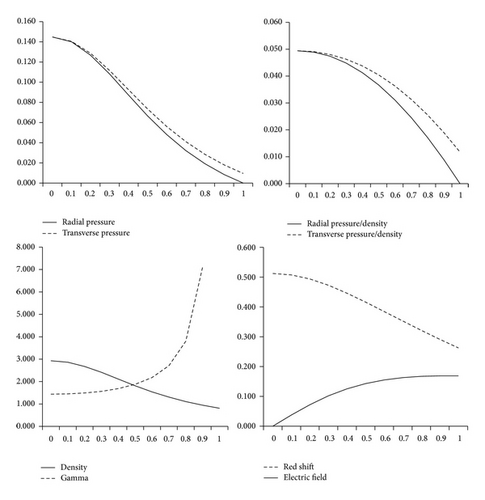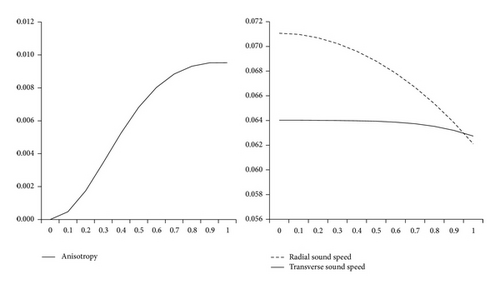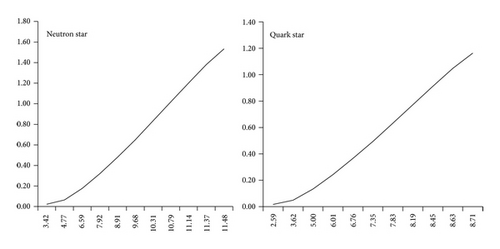Anisotropic Charged Fluid Sphere in Isotropic Coordinates
Abstract
We have presented a class of charged superdense star models, starting with a static spherically symmetric metric in isotropic coordinates for anisotropic fluid by considering Hajj-Boutros-(1986) type metric potential and a specific choice of electrical intensity E and anisotropy factor Δ which involve charge parameter K and anisotropy parameter α. The solution is well behaved for all the values of Schwarzschild compactness parameter u lying in the range 0 < u ≤ 0.2086, for all values of charge parameter K lying in the range 0.04 ≤ K ≤ 0.111 , and for all values of anisotropy parameter α lying in the range 0.016 ≥ α ≥ 0. With the increase in α, the values of K and u decrease. Further, we have constructed a superdense star model with all degree of suitability. The solution so obtained is utilized to construct the models for superdense star like neutron stars ρb = 2.7 × 1014 g/cm3 and strange quark stars ρb = 4.6888 × 1014 g/cm3 . For K = 0.06 and α = 0.01, the maximum mass of neutron star is observed as M = 1.53 M⊙ and radius R = 11.48 km. Further for strange quark stars M = 1.16 M⊙ and R = 8.71 km are obtained.
1. Introduction
- (i)
The presence of some charge may avert the catastrophic gravitational collapse by counterbalancing the gravitational attraction by the electric repulsion in addition to the pressure gradient.
- (ii)
The inclusion of charge inhibits the growth of space time curvature which has a great role in avoiding singularities (Ivanov [1]; de Felice et al. [2]).
- (iii)
Bonnor [3] pointed out that a dust distribution of arbitrarily large mass and small radius can remain in equilibrium against the pull of gravity by a repulsive force produced by a small amount of charge.
- (iv)
The solutions of Einstein-Maxwell equations are useful to study the cosmic matter.
- (v)
The charge dust models and electromagnetic mass models are providing some clue about the structure of electron (Bijalwan [4]) and Lepton model (Kiess [5]).
- (vi)
Several solutions which do not satisfy some or all the conditions for well-behaved nature can be renewed into well-behaved nature by charging them.
- (vii)
Maharaj-Takisa [6] pointed out that the astrophysical objects have essential characteristics of rotational motion, which is caused by the presence of anisotropic parameter. Therefore, the matter in reality cannot be perfect fluid; Ruderman [7] and Sharma and Maharaj [8] also justified that the anisotropic always prevails in a certain density range ≈1015 g/cm3.
- (viii)
Ivanov [9] pointed out that solutions in isotropic coordinates are more significant than the solutions in curvature coordinates, due to the following reasons: (a) the solutions in isotropic coordinates are simple in terms of algebraic expressions; (b) isotropic coordinates solutions can be used as seed solutions in Quasar modeling or nonstatic solutions.
- (a)
A neutron star has surface density ρb = 2.7 × 1014 g/cm3 (Astashenok [10]) and mass 1.4 M⊙ − 2.9 M⊙. However, Astashenok [10] established that f(R) models with realistic equation of state of neutron star have upper limit mass 2 M⊙ and minimal radius close to 9 km.
- (b)
A strange quark star has surface density ρb = 4.6888 × 1014 g/cm3 (Fatema and Murad [11]; Zdunik [12]) and possible maximum mass 2M⊙. However, Dong et al. [13] established that due to presence of half skyrmions in the dense baryonic matter the stable strange quark star can have upper mass limit up to 2.4M⊙.
In recent past, a considerable number of exact solutions with well-behaved nature of general relativistic field equation with anisotropic matter have been obtained; Dev and Gleiser [14], Komathiraj and Maharaj [15, 16], Thirukkanesh and Regel [17], Takisa and Maharaj [18, 19], Mak and Harko [20], Mak et al. [21], Ivanov [1], Maurya and Gupta [22, 23], Chaisi and Maharaj [24], and Feroze and Siddiqui [25] deal with curvature coordinates and some of them are charged models. By motivation of Maharaj-Takisa [6] and Ivanov [9], in this paper, we present a new class of well-behaved exact solutions of Einstein-Maxwell field equations in isotropic coordinates for anisotropic fluid assuming a particular form of one of the metric potentials and suitable choice of electric intensity and anisotropy.
2. Field Equations in Isotropic Coordinates
3. Conditions for Well-Behaved Solution
- (i)
The solution should be free from physical and geometrical singularities, that is, finite and positive values of central pressure, central density, and nonzero positive values of eω and eυ.
- (ii)
The radial pressure pr must be vanishing, but the tangential pressure p⊥ may not vanish at the boundary r = rb of the sphere. However, the radial pressure is equal to the tangential pressure at the centre of the fluid sphere.
- (iii)
The density ρ and pressures pr, p⊥ should be positive inside the star.
- (iv)
and so that pressure gradient dpr/dr is negative for 0 ≤ r ≤ rb.
- (v)
and so that pressure gradient dp⊥/dr is negative for 0 ≤ r ≤ rb.
- (vi)
(dρ/dr)r=0 = 0 and so that density gradient dρ/dr is negative for 0 ≤ r ≤ rb.
-
Conditions (iv)–(vi) imply that pressure and density should be maximum at the centre and monotonically decreasing towards the surface.
- (vii)
Inside the static configuration the casualty condition should be obeyed; that is, the speed of sound should be less than the speed of light; that is, and . In addition to the above the velocity of sound should be decreasing towards the surface; that is, (d/dr)(dpr/dρ) < 0 or (d2pr/dρ2) > 0 and (d/dr)(dp⊥/dρ) < 0 or (d2p⊥/dρ2) > 0 for 0 ≤ r ≤ rb; that is, the velocity of sound is increasing with the increase of density. In this context it is worth mentioning that the equation of state at ultrahigh distribution has the property that the sound speed is decreasing outwards (Canuto and Lodenquai [28]).
- (viii)
A physically reasonable energy-momentum tensor has to obey the conditions ρ ≥ pr + 2p⊥ and ρ + pr + 2p⊥ ≥ 0.
- (ix)
The central red shift Z0 and the surface red shift Zb should be positive and finite; that is, and and both should be bounded.
- (x)
Electric intensity E, such that Er=0 = 0 and is taken to be monotonically increasing.
- (xi)
The anisotropy factor Δ should be zero at the center and increasing towards the surface.
4. A New Class of Solutions
5. Properties of the New Solution
6. Boundary Conditions in Isotropic Coordinates
For exploring the boundary conditions, we use the principle that the metric coefficients gij and their first derivatives gij,k in interior solution (I) as well as in exterior solution (E) are continuous up to and on the boundary B. The continuity of metric coefficients gij of I and B on the boundary is the known first fundamental form. The continuity of derivatives of metric coefficients gij of I and B on the boundary is the known second fundamental form.
7. Discussions and Conclusions
From Figures 1 and 2 it has been observed that the physical quantities pr, p⊥, pr/ρc2, p⊥/ρc2, dpr/c2dρ, dp⊥/c2dρ, and z are positive at the centre and within the limit of realistic state equation and monotonically decreasing while the quantities γ, Δ, E are increasing for all values of K, α, and u lying in the ranges 0.04 ≤ K ≤ 0.111, 0 < α ≤ 0.016, and 0 ≤ u ≤ 0.2086, respectively. For K + α > 0.111 the pressure is negative. With the increase in the value of K from 0.04 to 0.111 the Schwarzschild parameter “u” increases; hence the mass increases, but the value of α has to be decreased to 0. With α = 0 we recover the isotropic model.


By increasing K above 0.111 the causality condition is obeyed throughout within the ball, but the trend of adiabatic sound speed (transversal) is erratic. Thus, the solution is well behaved for all values of u satisfying the inequality 0 ≤ u ≤ 0.2086 for K up to 0.111 and for α up to 0.016. From Figure 3 it is clearly shown that the mass of the superdense star has a linear dependence on its radius.

In Tables 1 and 2 we present a model of superdense neutron star and quark star based on the particular solution discussed above. By assuming surface density, ρb = 4.6888 × 1014 g/cm3 corresponding to α = 0.01, K = 0.06 for which u = 0.198, the resulting well-behaved solution has a maximum mass M = 1.16 M⊙ and radius R = 8.71 km (for quark star) and by assuming the surface density ρb = 2.7 × 1014 g/cm3 the obtained maximum mass is M = 1.53 M⊙ and radius R = 11.48 (for neutron star).
| u | Rb (km) | M/M⊙ | |
|---|---|---|---|
| 0.010 | 0.08605 | 3.41575 | 0.02299 |
| 0.020 | 0.16661 | 4.77451 | 0.06413 |
| 0.040 | 0.31173 | 6.59067 | 0.17622 |
| 0.060 | 0.44198 | 7.92405 | 0.32153 |
| 0.080 | 0.54874 | 8.91444 | 0.48155 |
| 0.100 | 0.63497 | 9.68137 | 0.65060 |
| 0.120 | 0.70596 | 10.31179 | 0.83478 |
| 0.140 | 0.75730 | 10.78723 | 1.01872 |
| 0.160 | 0.79117 | 11.13602 | 1.20163 |
| 0.180 | 0.80834 | 11.36756 | 1.38018 |
| 0.198 | 0.81007 | 11.47792 | 1.53364 |
| u | RB (km) | M/M⊙ | Zb | Ebrb | |
|---|---|---|---|---|---|
| 0.010 | 2.59201 | 0.01745 | 0.010101 | 0.008901 | 0.000026 |
| 0.020 | 3.62309 | 0.04866 | 0.020408 | 0.017722 | 0.000105 |
| 0.040 | 5.00127 | 0.13373 | 0.041667 | 0.035122 | 0.000411 |
| 0.060 | 6.01310 | 0.24399 | 0.064963 | 0.053045 | 0.000938 |
| 0.080 | 6.76465 | 0.36542 | 0.088850 | 0.070282 | 0.001646 |
| 0.100 | 7.34663 | 0.49370 | 0.113586 | 0.087017 | 0.002524 |
| 0.120 | 7.82502 | 0.63347 | 0.140901 | 0.104300 | 0.003626 |
| 0.140 | 8.18579 | 0.77305 | 0.169317 | 0.121076 | 0.004886 |
| 0.160 | 8.45047 | 0.91185 | 0.199472 | 0.137677 | 0.006318 |
| 0.180 | 8.62618 | 1.04734 | 0.231679 | 0.154199 | 0.007926 |
| 0.198 | 8.70992 | 1.16379 | 0.262626 | 0.169054 | 0.009526 |
Conflict of Interests
The authors declare that there is no conflict of interests regarding the publication of this paper.
Acknowledgments
The authors acknowledge their gratitude to Major General Ashok Ambre, SM, Deputy Commandant, NDA, for his motivation and encouragement. They also extend their gratitude to Professor O. P. Shukla, Principal, NDA, for his encouragement. They are grateful to the anonymous referees for their rigorous review, constructive comments, and useful suggestions.




